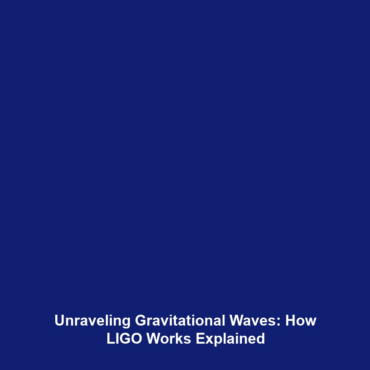How LIGO (Laser Interferometer Gravitational-Wave Observatory) Works
The Laser Interferometer Gravitational-Wave Observatory, or LIGO, represents a groundbreaking advancement in the field of astrophysics. Its primary purpose is to detect gravitational waves—ripples in spacetime caused by cataclysmic cosmic events such as merging black holes or neutron stars. Understanding how LIGO works is crucial not just for the scientific community, but for the broader exploration of the universe. This article delves into the mechanics behind LIGO, its real-world applications, current challenges, and future research avenues.
Key Concepts
LIGO operates on fundamental principles of physics and engineering that enable it to detect minute changes in distance caused by passing gravitational waves. Key concepts include:
-
Laser Interferometry
LIGO employs laser interferometry to measure changes in length with extraordinary precision—down to a fraction of the diameter of a proton. A laser beam is split into two perpendicular paths, and the time taken for each beam to return is compared. When a gravitational wave passes through, it distorts spacetime and causes variations in these paths.
-
Advanced Detection Techniques
Utilizing a network of observatories (LIGO in the United States and Virgo in Europe), scientists can triangulate the location of gravitational wave events, enhancing detection accuracy.
-
Sensitivity and Technology
Ongoing upgrades have improved LIGO’s sensitivity, allowing it to detect waves from further away and enabling the study of more distant and diverse phenomena.
Applications and Real-World Uses
The applications of LIGO and its detection of gravitational waves have revolutionized our understanding of the cosmos. Significant real-world applications include:
- Understanding Cosmic Events: LIGO’s ability to detect events like black hole mergers opens new avenues in astrophysical research, allowing scientists to study the properties of these mysterious entities and the energy they release.
- Testing General Relativity: LIGO provides empirical data to validate Einstein’s theory of general relativity in extreme conditions, confirming predictions about gravitational waves.
- Multimessenger Astronomy: The detection of electromagnetic signals associated with gravitational waves allows for a more holistic understanding of cosmic events, enhancing our knowledge in fields ranging from astrophysics to cosmology.
Current Challenges
Despite its successes, LIGO faces several challenges:
- Sensitivity Limitations: Although highly sensitive, there are still challenges in detecting weaker gravitational waves, necessitating ongoing technological developments.
- Noise Interference: Environmental factors and instrument noise can obscure signal detection, requiring advanced filtering techniques.
- Funding and Resource Allocation: Continuous improvements in technology and infrastructure require substantial funding and resources to maintain progress.
Future Research and Innovations
As LIGO continues to evolve, numerous innovations and research initiatives are on the horizon:
- Next-Generation Detectors: Projects like the Cosmic Explorer and the Einstein Telescope aim to enhance sensitivity and broaden the frequency range for gravitational wave detection.
- Integration with Other Observatories: Future collaborations with space-based detectors like LISA (Laser Interferometer Space Antenna) will provide a comprehensive view of gravitational wave sources across different wavelengths.
- Machine Learning Techniques: The application of machine learning algorithms will improve data analysis and event classification, helping identify true signals amid noise.
Conclusion
In summary, the Laser Interferometer Gravitational-Wave Observatory (LIGO) is a critical tool for understanding gravitational waves and the universe’s fabric. Its sophisticated technology, defined by laser interferometry and advanced detection methods, has sparked a new era of astrophysical research. As we continue to confront existing challenges and embrace future innovations, LIGO’s impact on both science and our understanding of the universe will only grow stronger. For further insights into gravitational waves and astrophysical phenomena, explore our other articles on [Gravitational Waves](#) and [Astrophysics](#).


